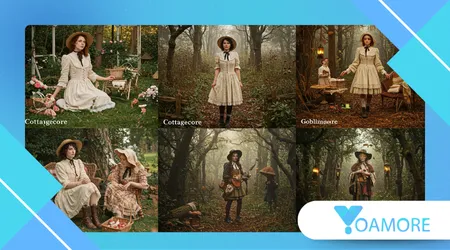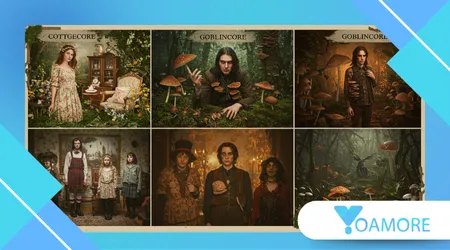Cottagecore to Goblincore: The Evolution of Online Subcultures

From Cottagecore to Goblincore, online subcultures have evolved into something much larger than aesthetics—they now reflect deeper values, resistance to societal norms, and a call for more humanized digital experiences.
Anúncios
In a world that increasingly defines us by speed and productivity, these movements offer a pause, a point of reflection, and an invitation to live differently.
But how did we get from fields of lavender to muddy mushrooms—and what does it say about our cultural moment?
Summary: This article explores the psychological, economic, social, and technological contexts of the aesthetic evolution from Cottagecore to Goblincore.
It investigates why such subcultures resonate in 2025, how they reflect shifting values, and what they reveal about identity, community, and self-expression in the digital age.
Anúncios
Digital Escapes Rooted in Real Longings
Cottagecore gained traction in early 2020, right when the pandemic confined millions indoors.
Its idealized vision of rural life—gardening, baking, embroidery, reading by candlelight—offered comfort amidst global chaos.
It wasn’t just about the aesthetic; it was about control, stillness, and simplicity in a time of deep uncertainty.
This yearning for serenity led many young people to create online identities aligned with the aesthetic.
On platforms like Instagram and TikTok, Cottagecore content bloomed: sourdough starters, hand-sewn dresses, filtered sunshine.
It was escapism, yes, but also protest. Protest against capitalism, hustle culture, environmental degradation, and digital exhaustion.
However, as the world adjusted and social awareness grew, a new sentiment crept in.
Cottagecore felt a bit too curated, a little too idealized. In response, Goblincore emerged. It celebrated decay, disorder, and the “ugly-beautiful”.
Moss, fungi, rusted objects, and cluttered desks became icons of a more raw, unfiltered self.
Also Read: Why Some Languages Have No Word for “Left” or “Right”
Chaos, Neurodivergence, and Belonging

The shift from Cottagecore to Goblincore marks more than just aesthetic preference; it’s a psychological and cultural pivot.
Goblincore appeals to individuals who feel out of place in polished, hyper-structured worlds. It’s about comfort in chaos, finding beauty in the imperfect, and rejecting societal pressure to be “clean” or ideal.
For many neurodivergent individuals, especially those with ADHD or autism, Goblincore feels like home. It doesn’t demand perfection.
It honors sensory richness, ritual, and collecting—traits often pathologized by mainstream narratives.
The TikTok hashtag #goblincore amassed over 2 billion views by late 2024, proving its resonance among youth seeking spaces where they can just be.
A 2024 study by the Journal of Cyberpsychology, Behavior, and Social Networking found that participation in aesthetic subcultures can reduce self-alienation and improve emotional regulation among digital natives.
These movements become more than styles—they’re lifelines.
+ The Aesthetic Microcultures of TikTok Explained
A Mirror to Capitalist Fatigue and Environmental Guilt
Cottagecore was, in many ways, the Instagram-era response to burnout. Goblincore, in contrast, looks unflinchingly at the wreckage of late capitalism.
It doesn’t romanticize the world; it confronts it, finds the hidden, decomposing beauty, and embraces it fully.
Both aesthetics push back against overconsumption. Cottagecore encourages handmade goods, sustainability, and slow living.
Goblincore amplifies this by rejecting polished products altogether—celebrating the secondhand, the broken, the wild.
It’s no coincidence that Goblincore also overlaps heavily with climate activism. Its followers frequently cite mushroom foraging, zero-waste lifestyles, and the rejection of plastic-heavy consumer goods.
According to a 2024 New York Times feature, the Goblincore community is considered one of the most eco-conscious groups on social media.
+ Understanding Modern Tribes: 10 Unique Micro Cultures
Platforms Shaping Subcultural Identity
While Tumblr was once the hub for aesthetic subcultures, TikTok now reigns. Its short-form video structure, interest-driven algorithm, and visual tools make it ideal for broadcasting aesthetics.
The evolution from Cottagecore to Goblincore was accelerated by this dynamic.
On TikTok, aesthetics aren’t consumed passively; they are co-created. Users don’t just follow trends—they dress, decorate, and build digital rituals around them.
Cottagecore had bread-baking and slow walks; Goblincore has “goblin mode” morning routines, junk drawer hauls, and shrine-like corners of collected objects.
This democratized participation allows for intersectionality. Queer, BIPOC, and neurodivergent voices find room to exist without bending to traditional media norms.
One creator, @foragedfemme, combines mushroom ID guides with queer history facts, amassing over 250K followers by mid-2025.
Blending Personal Identity with Aesthetic Values
Aesthetics today are less about decoration and more about identity formation. When someone aligns with Cottagecore to Goblincore, they’re not simply saying “I like flowers” or “I collect bones”.
They’re stating their values, preferences, neurology, and sometimes even political ideologies.
For example, many nonbinary and queer individuals find freedom in Goblincore’s genderless grime and embrace of the unconventional.
Others use Cottagecore as a soft armor—a way to imagine a world where kindness, gentleness, and domestic agency aren’t weaknesses.
In practice, this can affect career choices, relationships, and even living arrangements.
A growing number of digital nomads describe themselves as “cottagecore adjacent,” seeking rural or nature-integrated locations where they can work remotely while living simply.
From Moodboard to Market: The Aesthetic Economy
The monetization of aesthetics is well underway. From indie shops on Etsy to subscription boxes, creators are turning niche vibes into viable businesses.
Products range from hand-poured candles with forest scents to enamel pins featuring frogs in wizard hats.
| Aesthetic | Etsy Listings (2024) | Google Search Growth (YoY) | Monthly TikTok Views |
|---|---|---|---|
| Cottagecore | 520,000+ | +114% | 1.3 billion |
| Goblincore | 410,000+ | +245% | 2.1 billion |
Data from Shopify’s 2024 trend report showed that aesthetic-aligned microbusinesses had 38% higher engagement rates than generic product brands. People are buying not just things, but belonging.
Influence on Design, Education, and Work
Design trends increasingly reflect Goblincore’s rugged influence. UX/UI elements in niche productivity apps now incorporate earth tones, moss textures, and softer motion graphics.
In education, some teachers even adapt Goblincore principles to create neurodivergent-friendly classrooms—using sensory items, nature walks, and student-led learning.
Professionally, there’s a rise in alternative career paths tied to aesthetic subcultures.
People are becoming cottagecore gardeners, Goblincore-inspired illustrators, or creators of narrative-based games inspired by these worlds.
The lines between passion and profession blur, and authenticity becomes a unique value proposition.
According to Fast Company, 40% of Gen Z professionals in creative industries now claim their aesthetic identity directly informs their project choices or freelance work.
Cultural Reclamation and Inclusion
There has been warranted critique that early Cottagecore leaned too heavily into Eurocentric, whitewashed ideals.
Goblincore helped shift the narrative. Its grungy, unfiltered style invites broader participation and challenges colonial beauty standards.
People of all backgrounds are reclaiming ancestral connections through fungi, dirt, and folklore. It’s not performative; it’s deeply embodied.
For many, it offers cultural healing, particularly for those excluded from traditional wellness spaces.
As the movement expands, new terms emerge: “Chaoscore,” “Eco-goth,” and “Librarycore” blend and intersect. This fluidity proves that subcultures aren’t rigid silos but living languages for identity expression.
The Future of Subcultures: More Real Than Ever
Online aesthetics aren’t fleeting trends—they’re evolving cultural ecosystems. As long as we live in a digitized, market-driven world, people will continue to seek meaning and softness through visual subcultures.
Cottagecore to Goblincore may seem like opposite ends of a spectrum, but they actually form a loop: one seeking control and comfort, the other embracing disorder and truth.
Together, they provide a holistic vocabulary for modern identity.
And maybe that’s the most compelling truth: in aesthetic chaos, we find clarity.
To explore more on the intersection of culture and technology, visit MIT Technology Review.
Frequently Asked Questions (FAQ)
1. Can I identify with more than one aesthetic?
Absolutely! Most people float between different microcultures depending on mood, season, or life context.
2. Do these aesthetics have real-life impact?
Yes. They influence everything from the way we dress to our mental well-being and even career choices.
3. Is there an age limit for joining these subcultures?
Not at all. While young people often lead the charge, anyone can participate and find meaning.
4. Is Goblincore just a passing fad?
While aesthetics evolve, the core values of acceptance, sustainability, and authenticity are timeless.
5. Isn’t this all just fantasy?
It’s fantasy with purpose. Imagining new ways to live is a radical and deeply human act in challenging times.
